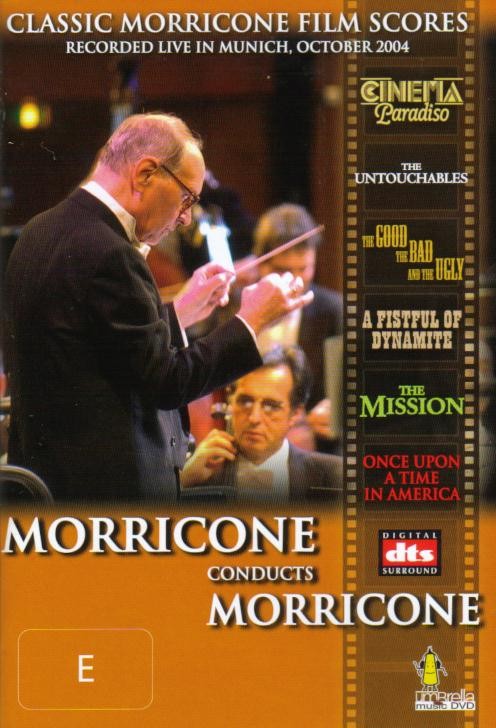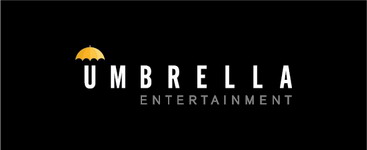Morricone Conducts Morricone (2004) |
|
Morricone Conducts Morricone (2004) |
|


|
| BUY IT |
| General | Extras | ||
| Category | Music | Trailer-Cinema Paradiso, Black Orpheus, Duke Ellington, Carmen Jones | |
| Rating |

|
||
| Year Of Production | 2004 | ||
| Running Time | 99:34 | ||
| RSDL / Flipper | RSDL (51:40) | Cast & Crew | |
| Start Up | Menu | ||
| Region Coding | 2,4 | Directed By | Giovanni Morricone |
|
Studio
Distributor |
 Umbrella Entertainment |
Starring |
Ennio Morricone Susanna Rigacci Gilda Butta Ulrich Herkenhoff Henry Raudales Norbert Merkl |
| Case | Amaray-Transparent | ||
| RPI | $24.95 | Music | Ennio Morricone |
| Video | Audio | ||
| Pan & Scan/Full Frame | None |
English Dolby Digital 5.1 (448Kb/s) English dts 5.1 (768Kb/s) English Linear PCM 44.1/16 2.0 (1536Kb/s) |
|
| Widescreen Aspect Ratio | 1.78:1 | ||
| 16x9 Enhancement |
 |
||
| Video Format | 576i (PAL) | ||
| Original Aspect Ratio | 1.78:1 | Miscellaneous | |
| Jacket Pictures | No | ||
| Subtitles | None | Smoking | No |
| Annoying Product Placement | No | ||
| Action In or After Credits | No | ||
At 77 Ennio Morricone is now perhaps the doyen of major film composers, having written many indelible scores over a career that extends to nearly half a century. Best known among these are his scores for the films of Sergio Leone, with whom he had gone to school in the 1930s. But his work encompasses many genres and many other directors, from the political films of Elio Petri to giallo potboilers to intimate and realistic dramas.
This DVD features a concert in Munich in October 2004 where the 75-year-old Morricone conducts music taken from his film scores, seamlessly blended together in what could be described as two long suites divided by a miniature violin concerto. Most of his best known music is included, though the first two westerns he did for Leone, and which made his name, are omitted. The music is lushly played by the Bavarian Radio Symphony Orchestra, augmented by piano, synthesiser, drums and guitar. As soloists we have soprano Susanna Rigachi and Ulrich Herkenhoff on the pan-pipes, while the orchestra's first violinist Henry Raudales plays the solo part in Canone Inverso.
The DVD has a blurb stating that the performance also features video excerpts from the films in question, but this only extends to brief snippets from Cinema Paradiso, The Good, the Bad and the Ugly and The Desert of the Tartars in rather poor quality video.
The concert might be a bit much to take all in one sitting. Out of context and played by an orchestra, many of the pieces sound alike, particularly in the second half of the programme. That being said there is much beautiful music here, such as the themes from Once Upon a Time in America and The Mission. The Ecstasy of Gold theme from The Good, the Bad and the Ugly gets an excellent performance with wordless vocals sung by choir and soprano reaching a thrilling climax. The concert footage is well directed by Morricone's son Giovanni, covering all of the contributors without being too flashy or self-conscious.
I can imagine that this programme would make an excellent CD for listening in the car, but as a video performance it is not something I would watch very often. It is a good investment if you like Morricone's music.
The concert seems to have been filmed on digital video for television and is therefore presented here in the original aspect ratio of 1.78:1 and 16x9 enhanced.
As far as filmed concerts in concert halls go the video presentation here is standard. There are some minor problems but nothing serious. The lighting is probably little or no brighter than for a normal performance and as a consequence there are plenty of shadows and a slight lack of detail. You can see the details on the faces of the conductor and his performers, including imperfections on their skin, but the image is never razor sharp, so details like fine wrinkles and individual strands of hair are not present.
Colour is reasonable without being vivid. Flesh tones are close to accurate. Shadow detail isn't the best but in this sort of material it isn't that important.
There are no film artefacts, this being a video recording. Video artefacts are limited to mild aliasing on straight edges (violin strings for example) and some Gibb Effect in the wider shots. There is also some blue flaring on the brass instruments on a couple of occasions.
There are no subtitles as there is no dialogue. The disc is RSDL-formatted and the layer break is ideally placed at 51:40 in the break between the two halves of the programme.
| Sharpness | |
| Shadow Detail | |
| Colour | |
| Grain/Pixelization | |
| Film-To-Video Artefacts | |
| Film Artefacts | |
| Overall |
There are three audio tracks. The default is Dolby Digital 5.1, with DTS 5.1 and Linear PCM 2.0 as alternatives. I listened to the DTS track in full and sampled the others for comparison. I note that on the audio selection menu, selecting Resume after choosing the audio track did not commence the main programme but instead started the disc from the beginning. This meant I got to see the copyright notice, Umbrella promo and rating screens again and ended up back at the main menu screen.
The audio is certainly well recorded, but I have reservations about the mixing, with the soundstage not very well presented across the front channels. The perspective seems to be from the audience point of view, with the audio laid out much as the orchestra would appear to be. The piano is to the extreme left, and this is where it appears to be in the audio. However, the string section also seems to be well to the left, whereas on screen you can see that it is located between the conductor and the piano. Therefore I would expect to hear it spread across the left half of the soundstage, not just from the left channel. This could be because the mix is awry or the level of the centre channel is too low. However the centre channel can be clearly heard on other instruments and vocals, so I suspect the former is the problem.
Otherwise there is good clarity to the sound of the instruments and they all sound realistic. At times there seems to be a bit more reverberation than at others. I also noted what sounds like distortion on some of the louder notes from the pan pipes.
The low frequency effects channel is well-utilised. As the overall volume level is quite high - I actually had the volume a few notches below my normal reference level - you might get a shock from the opening drumbeats. So might your neighbours. The subwoofer comes into play more frequently to reproduce low notes in a good mix with the rest of the audio, and it rarely draws attention to itself.
The Dolby Digital track sounds much the same as the DTS track, though not quite as loud. Perhaps the bass is slightly richer, but it is a close run thing. The Linear PCM track is also good, with a narrower soundstage than either of the surround tracks. The delineation of individual instruments seems better on the surround tracks as well.
| Dialogue | |
| Audio Sync | |
| Clicks/Pops/Dropouts | |
| Surround Channel Use | |
| Subwoofer | |
| Overall |
The only extras are a handful of trailers for other Umbrella releases, being Cinema Paradiso, Black Orpheus, Memories of Duke Ellington and Carmen Jones.
NOTE: To view non-R4 releases, your equipment needs to be multi-zone compatible and usually also NTSC compatible.
This programme seems to have been released worldwide with the same specifications. The US Region 1 is reported to have a booklet with a short essay about Morricone, not enough in my estimation to make it more desirable than the Region 4.
An enjoyable concert of some of the best work of one of cinema's most prolific composers, very well performed.
The video quality is very good, though with the usual artefacts of video recording in a darkened concert hall.
The audio quality is excellent apart from a couple of strident passages and a problematic sound mix.
No extras of note.
| Video | |
| Audio | |
| Extras | |
| Plot | |
| Overall |
| Review Equipment | |
| DVD | Sony DVP-NS9100ES, using HDMI output |
| Display | Sony VPL-HS60 LCD Projector projected to 80" screen. Calibrated with Digital Video Essentials (PAL). This display device is 16x9 capable. This display device has a maximum native resolution of 720p. |
| Audio Decoder | Built in to DVD Player, Dolby Digital and DTS. Calibrated with Ultimate DVD Platinum. |
| Amplification | Sony TA-DA9000ES for surrounds, Elektra Reference power amp for mains |
| Speakers | Main: B&W Nautilus 800; Centre: Tannoy Sensys DCC; Rear: Tannoy Revolution R3; Subwoofer: Richter Thor Mk IV |